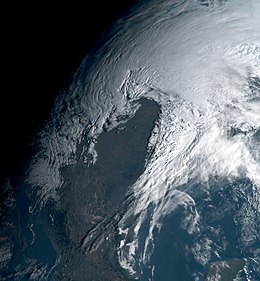 The extratropical cyclone responsible for the blizzard over the Midwestern United States at 14:01 UTC (10:01 a.m. CDT) on March 13. | |
| Type | Extratropical cyclone Bomb cyclone Blizzard Ice storm Winter storm Flood Windstorm Tornado outbreak |
|---|---|
| Formed | March 8, 2019 |
| Dissipated | March 16, 2019 |
| Highest gust | 109 mph (175 km/h) at Grand Prairie Airport |
| Lowest pressure | 968 mb (28.59 inHg) |
| Tornadoes confirmed | 38 |
| Max. rating1 | EF2 tornado |
| Duration of tornado outbreak2 | 2 days, 3 hours and 14 minutes |
| Maximum snowfall or ice accretion | 52 inches (130 cm) at Wolf Creek pass, Colorado |
| Fatalities | 1 |
| Damage | Unknown, at least $14.91 million tornadically |
| Power outages | 140,000+ |
| Areas affected | Southwestern United States, Rocky Mountains, Great Plains, Central United States, Eastern United States, Eastern Canada |
Part of the 2018–19 North American winter and tornado outbreaks of 2019 1Most severe tornado damage; see Enhanced Fujita scale 2Time from first tornado to last tornado | |
The March 2019 North American blizzard was a powerful Colorado Low that produced up to two feet of snow in the plains and Midwest. Rapid snowmelt following the storm caused historic flooding, and some areas received hurricane-force wind gusts. Comparable to the 1993 Storm of the Century,[1][2] the storm was labeled a bomb cyclone after barometric pressure readings dropped in excess of 24 mbar (0.71 inHg) over a 24-hour period.[3] After the storm entered Colorado from its origination in Arizona, the pressure dropped more than 30 mbar (0.89 inHg) and rapidly intensified over the western High Plains.[4] The severe storm set new all-time record low barometric pressure readings in Colorado, Kansas and New Mexico. The storm itself killed only one person in Colorado, but flooding caused by the storm killed at least 3, one in Iowa and at least two in Nebraska[5][6] and left ~140,000 without power in Texas.[7]
- ^ Linda Lam (March 15, 2019). "Another Superstorm? How the 2019 Bomb Cyclone Compared to the March 1993 Superstorm". The Weather Company. Retrieved March 17, 2019.
- ^ "Another Superstorm? How the 2019 Bomb Cyclone Compared to the March 1993 Superstorm". The Weather Channel. Retrieved 2019-03-26.
- ^ Lardieri, Alexa (March 13, 2019). "'Bomb Cyclone' Winter Storm Moving Across Central U.S." U.S. News & World Report. Retrieved March 13, 2019.
- ^ Spears, Chris (March 13, 2019). "'Bomb Cyclone' May Have Set Unofficial State Low Pressure In Colorado". CBS 4 Denver. Retrieved March 14, 2019.
- ^ "Bomb Cyclone Kills 2, Cripples Travel in Colorado, Great Plains". The Weather Channel. Retrieved 2019-03-16.
- ^ Cite error: The named reference
nbcwas invoked but never defined (see the help page). - ^ "Damaging storms spawn tornadoes in New Mexico, leave thousands without power in Texas - AccuWeather.com". m.accuweather.com. Retrieved 2019-03-16.